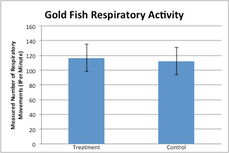By J. Stephens, B. Soucy, J. Moon, and J. Griffon
Gordon College,
Wenham, United States of America
INTRODUCTION
Caffeine is a stimulant widely used to keep people awake and to perk them up. There are a variety of physiological effects this substance has. This report focuses on the effect it has on metabolism. According to previous research, caffeine increases resting metabolic rate in
humans. Higher metabolic rate corresponds with an increase metabolism.1
Fish are animals as well, so caffeine should affect their bodies similarly. Caffeine binds to receptors in the brain to affect bodily function.2 No other studies have been conducted on how caffeine affects of goldfish. Thus, this is groundbreaking research.
The necessity of this research lies in the education of Gordon college students. In the process of brainstorming, conducting, then documenting an experiment they come to a greater understanding of experimentation and writing lab reports.
METHODS
We had a large fish tank containing 52 goldfish. In smaller fishbowls we put 250 mL of fish water. Using a net, we gathered fish into the bowls. For each set of data, each team had two fishbowls. One fish bowl had 7 drops of caffeine put into it, the other was kept as a control with only water.
Before measuring the respiratory rate, the fish were kept in the water for one minute to allow for the caffeine to take affect and for the fish to adjust to its new environment. Moving tanks startled the fish, increasing their heart rates. To measure the respiratory rate, someone watched the fish for 60 seconds, counting the number of times their opercula flapped.
This was repeated three times for each fish, and then the average of these were taken for final results.
Following, the fish would be scooped back out with a fish net and let into a clean rehabilitation tank, and more fish were put into the control and treatment fishbowls.
RESULTS
Description of included studies
Data was gathered from studying fish treated with caffeine as well as from a control group of fish in untreated water. The specific results of the tests are listed in Table 1.
A standard deviation for the average of these results was found for the treatment group and the control group of fish. Each group tested about five fish. The average respiratory rate and standard deviation are listed in Figure 1.
Figure 1 Averages and standard deviation of treatment and control goldfish
respiration rates.
Table 1 Averages of three measurements of one fish’s operculum flaps per
minute.
Using the T test to find the mean of each set of data, we found that caffeine increases the metabolic rate of goldfish by an average of 4bpm after the fish has been exposed to caffeine for only a minute.
DISCUSSION
No articles were found related directly to the affect caffeine had on respiration rate, which made this study more interesting, but less informed. There was a study that found caffeine to improve the metabolic resting rate, which in this study may be the reason for a slightly higher respiration rate in the goldfish.
As expected, there was a correlation between fish and humans.3 Humans’ metabolic rate increases with caffeine,4 and similarly goldfish respiration rate increased. This probably meant an increase in respiration rate as well.
In the future, tests to confirm this connection between metabolic resting rate and respiration rate on
REFERENCES
1.
Roberts AT, De Jonge-Levitan L,
Parker, CC, Greenway FL (2005) The Effect
of an Herbal Supplement Containing Black Tea and Caffeine on Metabolic
Parameters in Humans. Alternative Medicine Review. Vol. 10 Issue 4, p321-325
2.
Pelligrino, D. A., Hao-Liang, X., & Vetri,
F. (2010). Caffeine and the Control of Cerebral Hemodynamics. Journal Of
Alzheimer’s Disease, 2051-62. doi:10.3233/JAD-2010-091261
3.
Ligo M, Ohtani-Kaneko R, Hara M,
Hirata K, Aida K (1997) Melatonin Binding Sites in the Goldfish Retina. Zoological
Science. 14: 601-607
4.
Burrows, T., Pursey, K., Neve, M.,
& Stanwell, P. (2013). What are
the health implications associated with the consumption of energy drinks? A
systematic review. Nutrition Reviews, 71(3), 135-148. doi:10.1111/nure.12005
Cui Z, Wang Y (2007) Temporal changes in body mass,
body composition and metabolism of gibel carp Carassius
auratus gibelio during food deprivation. J. Appl.
Ichthyol. 23: 215–220

